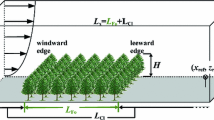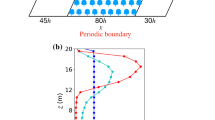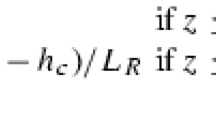Abstract
Little is known about in-canopy processes that may alter forest–atmosphere exchanges of trace gases and aerosols. To improve our understanding of in-canopy mixing, we use large-eddy simulation to study the effect of scalar source/sink distributions on scalar concentration moments, fluxes, and correlation coefficients within and above an ideal forest canopy. Scalars are emitted from: (1) the ground, (2) the canopy, and (3) both the ground and the canopy; a scalar is also deposited onto the canopy. All scalar concentration moments, fluxes, and correlation coefficients are affected by the source location/distribution, as is the scalar segregation intensity. We conclude that vertical source/sink distribution has a profound impact on scalar concentration profiles, fluxes, correlation coefficient, and scalar segregation.
Similar content being viewed by others
References
Auger L, Legras B (2007) Chemical segregation by heterogeneous emissions. Atmos Environ 41: 2303–2318
Baldocchi DD, Meyers TP (1991) Trace gas-exchange above the floor of a a deciduous forest 1. Evaporation and CO2 efflux. J Geophys Res-Atmos 96: 7271–7285
Baldocchi DD, Guenther A, Harley P et al (1995) The fluxes and air chemistry of isoprene above a deciduous hardwood forest. Philos Trans Roy Soc A 351: 279–296
Bohm M, Raupach MR, Finnigan JJ (2000) The effect of scalar source distribution on eddy diffusivities and bulk transfer coefficients. In: Proceedings of 24th conference on Agricultural and forest meteorology, Davis, CA, USA
Brown KW, Covey W (1966) The energy budget evaluation of the micrometeorology logical transfer processes within a cornfield. Agric For Meteorol 3: 73–96
Cassini M, Radicchi A, Albertson JD (2007) Modelling of concentration fluctuations in canopy turbulence. Boundary-Layer Meteorol 122: 655–681
Coppin PA, Raupach MR, Legg BJ (1986) Experiments on scalar dispersion within and model plant canopy 2: An elevated plane source. Boundary-Layer Meteorol 35: 167–191
Deardorff JW (1980) Stratocumulus-capped mixed layers derived from a three-dimensional model. Boundary-Layer Meteorol 18: 495–527
de Arellano JVG (2003) Bridging the gap between atmospheric physics and chemistry in studies of small scale turbulence. Bull Am Meteorol Soc 84: 51–56
Denmead OT, Bradley EF (1987) On scalar transport in plant canopies. Irrig Sci 8: 131–149
Finnigan JJ (2000) Turbulence in plant canopies. Annu Rev Fluid Mech 32: 519–571
Finnigan JJ, Shaw RH (2008) Double-averaging methodology and its application to turbulent flow in and above vegetation canopies. Acta Geophys 56: 534–561
Finnigan JJ, Shaw RH, Patton EG (2009) Turbulence structure above a vegetation canopy. J Fluid Mech 637: 387–424
Fuentes JD, Wang D, Bowling DR et al (2007) Biogenic hydrocarbon chemistry within and above a mixed deciduous forest. J Atmos Chem 56: 165–185
Gao W, Shaw R, Paw UKT (1989) Observation of organized structure in turbulent-flow within and above a forest canopy. Boundary-layer Meteorol 47: 349–377
Guenther A, Baugh W, Davis K et al (1996) Isoprene fluxes measured by enclosure, relaxed eddy accumulation, surface layer gradient, mixed layer gradient, and mixed layer mass balance techniques. J Geophys Res-Atmos 101: 18555–18567
Guenther A, Karl T, Harley P et al (2006) Estimates of global terrestrial isoprene emissions using MEGAN (Model of Emissions of Gases and Aerosols from Nature). Atmos Chem Phys 6: 3181–3210
Haugen DA, Kaimal JC, Bradley EF (1971) An experimental study of Reynolds stress and heat flux in the atmospheric boundary layer. Q J R Meteorol Soc 97: 349–377
Jardine K, Harley P, Karl T et al (2008) Plant physiological and environmental controls over the exchange of acetaldehyde between forest canopies and the atmosphere. Biogeosciences 5: 1559–1572
Karl T, Harley P, Guenther A et al (2005) The bi-directional exchange of oxygenated VOCs between a loblolly pine (Pinus taeda) plantation and the atmosphere. Atmos Chem Phys 5: 3015–3031
Krol MC, Molemaker J, de Arellano JVG (2000) Effects of turbulence and heterogeneous emissions on the active species in the convective boundary layer. J Geophys Res 105: 6871–6884
Lee XH, Black TA (1993) Atmospheric turbulence within and above a Douglas-Fir Stand 2. Eddy Fluxes of sensible heat and water vapor. Boundary-Layer Meteorol 64: 369–389
Moeng CH (1984) A large eddy simulation model for the study of planetary boundary-layer turbulence. J Atmos Sci 41: 2052–2062
Moeng C, Sullivan P (1994) A comparison of shear-driven and buoyancy-driven planetary boundary layers. J Atmos Sci 51: 999–1022
Moeng C, Wyngaard J (1988) Spectral analysis of large eddy simulations of the convective boundary layer. J Atmos Sci 45: 3573–3587
Patton EG, Davis KJ, Barth MC, Sullivan PP (2001) Decaying scalars emitted by a forest canopy: a numerical study. Boundary-Layer Meteorol 100: 91–129
Patton E, Sullivan P, Davis K (2003) The influence of a forest canopy on top-down and bottom-up diffusion in the planetary boundary layer. Q J R Meteorol Soc 129: 1415–1434
Patton E, Sullivan P, Moeng C (2005) The influence of idealized heterogeneity on wet and dry planetary boundary layers coupled to the land surface. J Atmos Sci 65: 2078–2097
Pope S (2000) Turbulent flows. Cambridge University Press, Cambridge 771 pp
Rannik U, Keronen P, Hari P, Vesala T (2004) Estimation of forest–atmosphere CO2 exchange by eddy covariance and profile techniques. Agric For Meteorol 126: 141–155
Raupach MR, Shaw RH (1982) Averaging procedures for flow within vegetation canopies. Boundary-Layer Meteorol 22: 79–90
Raupach MR, Finnigan JJ, Brunet Y (1996) Coherent eddies and turbulence in vegetation canopies: the mixing layer analogy. Boundary-Layer Meteorol 78: 351–382
Schmid HP, Su HB, Vogel CS, Curtis, PS (2003) Ecosystem–atmosphere exchange of carbon dioxide over a mixed hardwood forest in northern lower Michigan. J Geophys Res-Atmos. doi:10.1029/2002JD003011
Shaw RH, Schumann U (1992) Large eddy simulation of turbulent flow above and within a forest. Boundary-Layer Meteorol 61: 47–64
Shen S, Leclerc M (1997) Modelling the turbulence structure in the canopy layer. Agric For Meteorol 87: 3–25
Spalart P, Moser R, Rogers M (1991) Spectral methods for the Navier–Stokes equations with one infinite and two periodic directions. J Comput Phys 96: 297–324
Sparks JP, Monson R, Sparks K, Lerdau M (2001) Leaf uptake of nitrogen dioxide (NO2) in a tropical wet forest: implications for tropospheric chemistry. Oecologia 127: 214–221
Su HB, Shaw R, Paw UK, Moeng C, Sullivan P (1998) Turbulence statistics of neutrally stratified flow within and above a sparse forest from large eddy simulations and field observations. Boundary-Layer Meteorol 88: 363–397
Sullivan PP, Patton EG (2008) A highly parallel algorithm for turbulence simulations in planetary boundary layers: Results with meshes up to 10243. In: Proceedings of 18th American Meteorological Society, Stockholm, Sweden, June 2008
Sullivan PP, Patton EG (2011) The effect of mesh resolution on convective boundary layer statistics and structures generated by large-eddy simulation. J Atmos Sci 68: 2395–2415
Thom AS (1971) Momentum absorption by vegetation. Q J R Meteorol Soc 97: 414–428
Author information
Authors and Affiliations
Corresponding author
Rights and permissions
About this article
Cite this article
Edburg, S.L., Stock, D., Lamb, B.K. et al. The Effect of the Vertical Source Distribution on Scalar Statistics within and above a Forest Canopy. Boundary-Layer Meteorol 142, 365–382 (2012). https://doi.org/10.1007/s10546-011-9686-1
Received:
Accepted:
Published:
Issue Date:
DOI: https://doi.org/10.1007/s10546-011-9686-1




